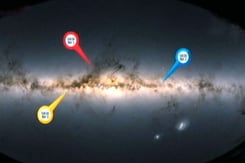Astronomers
- All
- News
- Videos
- Web Stories
-

Planet-Eating Stars Offer a Glimpse Into Earth’s Fate as the Sun Nears Its Final Stages
- Monday December 22, 2025
Astronomers studying aging Sun-like stars have found strong evidence that stars consume their closest planets as they evolve. Using data from NASA’s TESS mission, researchers observed fewer planets around older stars, suggesting worlds are destroyed over time. The findings offer a realistic preview of Earth’s fate billions of years from now.
-
 www.gadgets360.com
www.gadgets360.com
-

Hubble Captures Rare Collision in Nearby Planetary System, Revealing Violent Planet Formation
- Friday December 19, 2025
Astronomers using NASA’s Hubble Space Telescope have witnessed rare collisions between rocky bodies in the Fomalhaut system. The glowing debris clouds created by these impacts offer a unique glimpse into how planets form and highlight challenges in identifying true exoplanets.
-
 www.gadgets360.com
www.gadgets360.com
-

Astronomers Observe Black Hole Twisting Spacetime for the First Time, Confirming Einstein’s Theory
- Friday December 19, 2025
Astronomers have directly observed a black hole twisting spacetime for the first time, confirming Einstein’s long-standing prediction. The effect was detected during a violent stellar destruction event, where repeating X-ray and radio signals revealed a slow cosmic wobble. The discovery provides new insight into black hole spin, jets, and extreme...
-
 www.gadgets360.com
www.gadgets360.com
-

"Kids Feared I Was Going To Die": Kristin Cabot After Coldplay Kiss Cam Scandal
- Friday December 19, 2025
- World News |
Cabot revealed that the incident caused severe trauma for her children, who faced public shaming and safety fears.
-
 www.ndtv.com
www.ndtv.com
-

"How Dare She...": HR Behind Coldplay Kiss Cam Scandal Slams Gwyneth Paltrow
- Friday December 19, 2025
- World News |
Kristin Cabot, the former Chief People Officer at Astronomer, has been in the news since she was spotted on the "kiss cam" with her then boss, Andy Byron, during a Coldplay concert in July.
-
 www.ndtv.com
www.ndtv.com
-

Understanding Winter Solstice: All About Shortest Day Of The Year
- Thursday December 18, 2025
- World News | Associated Press
The solstices mark the times when the Earth's tilt toward or away from the sun is at its maximum. This means the hemispheres are getting very different amounts of sunlight - and days and nights are at their most unequal.
-
 www.ndtv.com
www.ndtv.com
-

James Webb Telescope Finds Evidence Of Giant "Dinosaur" Stars From Early Universe
- Tuesday December 16, 2025
- Science |
The research also suggests that these massive stars transformed directly into black holes at the end of their lives without undergoing a supernova explosion.
-
 www.ndtv.com
www.ndtv.com
-

Astronomers Witness Longest-Lasting Gamma-Ray Burst in History, 8 Billion Light-Years Away
- Tuesday December 16, 2025
A gamma-ray burst lasting over seven hours was recorded 8 billion light-years away, revealing a rare type of cosmic explosion and challenging current astrophysics models.
-
 www.gadgets360.com
www.gadgets360.com
-

Astronomers Watch a Dormant Neutron Star Reignite After a Decade of Silence
- Monday December 15, 2025
Astronomers observed a neutron star known as P13 suddenly brighten after years of inactivity. The decade-long study shows how changes in accretion can drive extreme X-ray power, offering new insight into ultraluminous X-ray sources and neutron star physics.
-
 www.gadgets360.com
www.gadgets360.com
-

Scientists Study Ancient Interstellar Comet 3I/ATLAS, Seeking Clues to Early Star System Formation
- Sunday December 14, 2025
Comet 3I/ATLAS, a rare interstellar visitor from beyond the solar system, is putting on a striking celestial show as it nears Earth. After passing perihelion in October, the comet brightened nearly tenfold and shifted from red to green due to glowing carbon molecules. Tracked closely by astronomers worldwide, this ancient object offers a unique opp...
-
 www.gadgets360.com
www.gadgets360.com
-

JWST Detects Thick Atmosphere on Ultra-Hot Rocky Exoplanet TOI-561 b
- Sunday December 14, 2025
Astronomers using the James Webb Space Telescope have discovered compelling evidence of a thick atmosphere surrounding TOI-561 b, an ultra-hot rocky exoplanet orbiting its star every 11 hours. Despite extreme radiation and molten surface conditions, the planet appears cooler than expected, suggesting heat-redistributing atmospheric winds and volati...
-
 www.gadgets360.com
www.gadgets360.com
-

Planet-Eating Stars Offer a Glimpse Into Earth’s Fate as the Sun Nears Its Final Stages
- Monday December 22, 2025
Astronomers studying aging Sun-like stars have found strong evidence that stars consume their closest planets as they evolve. Using data from NASA’s TESS mission, researchers observed fewer planets around older stars, suggesting worlds are destroyed over time. The findings offer a realistic preview of Earth’s fate billions of years from now.
-
 www.gadgets360.com
www.gadgets360.com
-

Hubble Captures Rare Collision in Nearby Planetary System, Revealing Violent Planet Formation
- Friday December 19, 2025
Astronomers using NASA’s Hubble Space Telescope have witnessed rare collisions between rocky bodies in the Fomalhaut system. The glowing debris clouds created by these impacts offer a unique glimpse into how planets form and highlight challenges in identifying true exoplanets.
-
 www.gadgets360.com
www.gadgets360.com
-

Astronomers Observe Black Hole Twisting Spacetime for the First Time, Confirming Einstein’s Theory
- Friday December 19, 2025
Astronomers have directly observed a black hole twisting spacetime for the first time, confirming Einstein’s long-standing prediction. The effect was detected during a violent stellar destruction event, where repeating X-ray and radio signals revealed a slow cosmic wobble. The discovery provides new insight into black hole spin, jets, and extreme...
-
 www.gadgets360.com
www.gadgets360.com
-

"Kids Feared I Was Going To Die": Kristin Cabot After Coldplay Kiss Cam Scandal
- Friday December 19, 2025
- World News |
Cabot revealed that the incident caused severe trauma for her children, who faced public shaming and safety fears.
-
 www.ndtv.com
www.ndtv.com
-

"How Dare She...": HR Behind Coldplay Kiss Cam Scandal Slams Gwyneth Paltrow
- Friday December 19, 2025
- World News |
Kristin Cabot, the former Chief People Officer at Astronomer, has been in the news since she was spotted on the "kiss cam" with her then boss, Andy Byron, during a Coldplay concert in July.
-
 www.ndtv.com
www.ndtv.com
-

Understanding Winter Solstice: All About Shortest Day Of The Year
- Thursday December 18, 2025
- World News | Associated Press
The solstices mark the times when the Earth's tilt toward or away from the sun is at its maximum. This means the hemispheres are getting very different amounts of sunlight - and days and nights are at their most unequal.
-
 www.ndtv.com
www.ndtv.com
-

James Webb Telescope Finds Evidence Of Giant "Dinosaur" Stars From Early Universe
- Tuesday December 16, 2025
- Science |
The research also suggests that these massive stars transformed directly into black holes at the end of their lives without undergoing a supernova explosion.
-
 www.ndtv.com
www.ndtv.com
-

Astronomers Witness Longest-Lasting Gamma-Ray Burst in History, 8 Billion Light-Years Away
- Tuesday December 16, 2025
A gamma-ray burst lasting over seven hours was recorded 8 billion light-years away, revealing a rare type of cosmic explosion and challenging current astrophysics models.
-
 www.gadgets360.com
www.gadgets360.com
-

Astronomers Watch a Dormant Neutron Star Reignite After a Decade of Silence
- Monday December 15, 2025
Astronomers observed a neutron star known as P13 suddenly brighten after years of inactivity. The decade-long study shows how changes in accretion can drive extreme X-ray power, offering new insight into ultraluminous X-ray sources and neutron star physics.
-
 www.gadgets360.com
www.gadgets360.com
-

Scientists Study Ancient Interstellar Comet 3I/ATLAS, Seeking Clues to Early Star System Formation
- Sunday December 14, 2025
Comet 3I/ATLAS, a rare interstellar visitor from beyond the solar system, is putting on a striking celestial show as it nears Earth. After passing perihelion in October, the comet brightened nearly tenfold and shifted from red to green due to glowing carbon molecules. Tracked closely by astronomers worldwide, this ancient object offers a unique opp...
-
 www.gadgets360.com
www.gadgets360.com
-

JWST Detects Thick Atmosphere on Ultra-Hot Rocky Exoplanet TOI-561 b
- Sunday December 14, 2025
Astronomers using the James Webb Space Telescope have discovered compelling evidence of a thick atmosphere surrounding TOI-561 b, an ultra-hot rocky exoplanet orbiting its star every 11 hours. Despite extreme radiation and molten surface conditions, the planet appears cooler than expected, suggesting heat-redistributing atmospheric winds and volati...
-
 www.gadgets360.com
www.gadgets360.com


















![Gadgets 360 With Technical Guruji: Did You Know? [April 6, 2024] Gadgets 360 With Technical Guruji: Did You Know? [April 6, 2024]](https://c.ndtvimg.com/2024-02/mpconh58_did-you-know_640x480_10_February_24.jpg?downsize=245:163)




